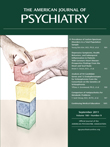To the Editor: We thank Drs. Harvey and Kornstein for their comments about the approach to determining the presence of premenstrual mood changes.
We concur that prospective mood charting is the most valid way to establish the occurrence of premenstrual mood symptoms and that, in the absence of this approach, some women with affective disorders will misattribute changes in their mood that are unrelated to the menstrual cycle as premenstrual mood exacerbation. Studies of the validity of retrospective reporting have not been conducted in women with bipolar disorder who endorse premenstrual exacerbation of their underlying mood disorder. However, it is likely that some women with bipolar disorder who retrospectively endorse premenstrual mood exacerbation may not show premenstrual mood exacerbation when their moods are monitored prospectively. This is consistent with what has been observed in women with unipolar depression. Treatments targeting premenstrual mood exacerbation in women with affective illness should utilize prospective mood rating before initiating interventions directed at premenstrual mood exacerbation, especially when the intervention is circumscribed within the luteal phase of the menstrual cycle (e.g., intermittent dosing of a selective serotonin reuptake inhibitor) or involves a hormonal contraceptive therapy.
Data used to support the determination of premenstrual mood exacerbation in our Systematic Treatment Enhancement Program for Bipolar Disorder (STEP-BD) analysis were limited to retrospective reporting of the pattern of mood exacerbation. While prospective mood rating was not available to more definitively establish the premenstrual mood exacerbation pattern, our classification was further supported by other correlative data. These supporting data included a strong association between premenstrual mood exacerbation status and the number of mood and physical symptoms endorsed on a separate itemized list. In addition, women classified as having premenstrual mood exacerbation were not more likely than those without it to be in the luteal phase when they completed the questionnaire describing their symptoms. This latter finding is important because it argues against a bias that women assessed as having premenstrual mood exacerbation are more likely to report premenstrual mood symptoms simply because they were evaluating their mood when premenstrual. As Drs. Harvey and Kornstein recommend, STEP-BD, like the Sequenced Treatment Alternatives to Relieve Depression study (STAR*D), collected data on the date of the last menstrual period for each woman at each visit. These data are critical for any observational and intervention study in women of premenopausal age.
While prospective mood rating data would have further strengthened our findings, such intensive data collection is often not available in a standard clinical setting when patients retrospectively report that they have a history of premenstrual mood exacerbation. Our results emphasize the importance of inquiring about a pattern of premenstrual worsening of mood and closely monitoring and optimizing therapy for women who report this premenstrual mood exacerbation pattern because of a heightened risk of relapse and greater symptom burden over time.

